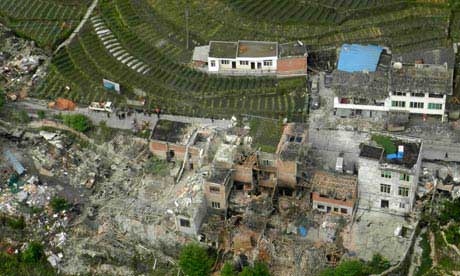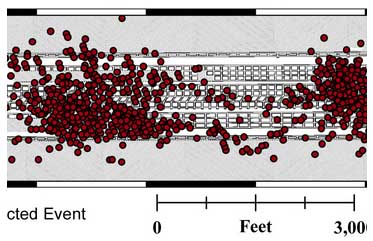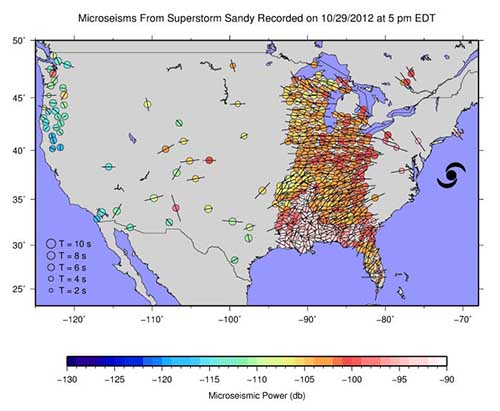Earthquakes April 2013
How Earthquakes in Chile Have Permanently Deformed Earth Live Science - April 29, 2013
Earthquakes can permanently crack the Earth, an investigation of quakes that have rocked Chile over the past million years suggests. Although earthquakes can wreak havoc on the planet's surface, more than a century of research has suggested the Earth actually mostly rebounds after quakes, with blocks of the world's crust elastically springing back, over the course of months to decades, to the way they initially were. Such rebounding was first seen after investigations of the devastating 1906 San Francisco temblor that helped lead to the destruction of more than 80 percent of the city. The rebound is well-documented nowadays by satellite-based GPS systems that monitor Earth's movements. However, structural geologist Richard Allmendinger of Cornell University and his colleagues now find major earthquakes of magnitude 7 or greater apparently caused the crust in northern Chile to crack permanently.
Moderate earthquake strikes western Mexico, no major damage Reuters - April 28, 2013
A magnitude 5.9 earthquake struck western Mexico on Sunday, shaking buildings in the capital, but there were no reports of significant damage or injuries, officials said. The quake, initially reported as a magnitude 6.2 off the coast, was centered 33 km (20 miles) northwest of La Union, on the border between Guerrero and Michoacan states, close to the Pacific coast, the U.S. Geological Survey said.
3.2-mag. earthquake near LAX shakes wide area of Southern California ABC - April 26, 2013
A 3.2-magnitude earthquake that hit near Los Angeles International Airport Friday night was felt widely across Southern California. The quake hit at 7:52 p.m. and was centered just 1 mile northeast of LAX. No damage or injuries were reported.
Amid wreckage of China quake, the desperate search for survivors CNN - April 22, 2013

Families badly in need of food and water are living in makeshift shelters near the shattered remains of their houses in this area of the southwestern Chinese province of Sichuan where a strong earthquake struck over the weekend, killing at least 188 people.
Images from CNN April 20, 2013
What Caused The Deadly China Earthquake? Live Science - April 22, 2013
The strong earthquake that struck China's Sichuan province at 8:47 a.m. local time Saturday (April 20) probably hit along the same fault as the region's devastating 2008 earthquake, according to the U.S. Geological Survey. The epicenter of the magnitude-6.6 earthquake was likely on the Longmen Shan Fault, the USGS said in a report on the April 20 quake. It was centered at a relatively shallow 7.6 miles (12.3 kilometers) below the surface, similar to the 2008 temblor. The 2008 earthquake, a magnitude 7.9, killed more than 69,000 people and released 89 times more energy than yesterday's earthquake. The Longmen Shan Fault is actually a zone of tectonically-related thrust faults that mark the boundary between the high Tibetan Plateau and the Sichuan Basin lowlands. With each earthquake, a fault thrusts the plateau over the basin, shortening the distance between the two regions. The fault zone stretches more than 150 miles (240 km) along the base of the Longmen Shan Mountains. The mountain front is known for its amazingly steep rise - from 2,000 feet (600 meters) elevation in the basin to 21,325 feet (6,500 m) in the mountains, all in just 30 miles (50 km).
2013 Lushan earthquake Wikipedia
Breaking the Ice: Earthquakes Trigger Antarctic 'Icequakes' Live Science - April 22, 2013
When the world shakes, so does Antarctica's ice, according to a study presented here April 19 at the Seismological Society of America's annual meeting. Icequakes are vibrations in glaciers and ice sheets (the massive expanses of glacial ice that cover Antarctica and Greenland). From small creaks and groans to sudden slips equal to a magnitude-7 earthquake, the shaking signals movement in the ice. Scientists discovered that big earthquakes, including Japan's 2011 Tohoku quake and Chile's 2010 Maule temblor, set off icequakes across Antarctica, just as they triggered earthquakes on land.
 7.0 quake hits ocean off Japan, Russia; no damage AP - April 19, 2013
7.0 quake hits ocean off Japan, Russia; no damage AP - April 19, 2013
The Japan Meteorological Agency said sea changes were possible. No tsunami warnings have been issued. The tremor struck around midday in the Pacific Ocean at a relatively shallow depth of 10 kilometers (6.2 miles). The U.S. Geological Survey measured a stronger 7.2 magnitude. Japan and Russia both claim some of the sparsely populated islands in the remote region.
6.0-Magnitude Earthquake Strikes Off Kuril Islands Live Science - April 19, 2013
Earthquakes of this size are considered major and can cause significant damage, especially with poorly built structures. Even well designed buildings can be damaged or, in some cases, destroyed depending on the severity of the quake and a building's proximity to the epicenter. Earthquakes of this size are sometimes followed by significant aftershocks.
Mine Disaster - Earthquakes Shed New Light on Utah Collapse Live Science - April 19, 2013

One of Utah's deadliest mine disasters may have brought down the entire Crandall Canyon coal mine, according to a new seismic study presented today (April 19) at the Seismological Society of America's annual meeting in Salt Lake City. At Crandall Canyon, a room carved from coal collapsed 1,500 feet (457 meters) below the surface on Aug. 6, 2007, trapping six workers. A tunnel collapse on Aug. 16 killed three rescuers digging toward the suspected location of the miners. The bodies of the six miners were never recovered. With new analysis techniques, researchers at the University of Utah identified up to 2,000 tiny, previously unrecognized earthquakes before, during and after the coal mine collapse.
Earthquakes Are East Coast's Biggest Tsunami Threat Live Science - April 19, 2013
The U.S. East Coast's biggest tsunami threat lurks just offshore, according to research presented today (April 19) at the Seismological Society of America's annual meeting in Salt Lake City. Recent earthquake swarms off the Massachusetts coast highlight the threat of tsunamis from nearby earthquakes, rather than faraway islands, said John Ebel, a seismologist at Boston College. The geologic setting of the quakes off the Northeast appears similar to that of a magnitude-7.3 earthquake that struck in the Grand Banks off Newfoundland in 1929, Ebel said. The resulting 32-foot (10 meters) tsunami swamped southern Newfoundland and triggered underwater landslides that severed transatlantic telephone cables.
Superstorm Sandy Shook the U.S., Literally Science Daily - April 18, 2013

When superstorm Sandy turned and took aim at New York City and Long Island last October, ocean waves hitting each other and the shore rattled the seafloor and much of the United States -- shaking detected by seismometers across the country, University of Utah researchers found.
Quite a Jolt: Earthquakes Heralded Opening of Sinkhole Live Science - April 17, 2013
Earthquakes signaled the opening of a giant toxic sinkhole in southeastern Louisiana last year, researchers reported here today at the Seismological Society of America's annual meeting. Strong shaking first rattled residents of Bayou Corne on June 8 and July 3 in 2012, prompting officials to install earthquake monitors near the small town. After July 14, seismometers detected 10 to 12 sharp tremors of about magnitude 2.5 jolting the region daily, said Steve Horton, a seismologist at the University of Memphis and lead study author.
Salt Lake City Could See Bigger Earthquakes Live Science - April 17, 2013
Two faults bounding Utah's biggest city may combine to produce especially powerful earthquakes, geologists will report in Salt Lake City today (April 17) at the annual meeting of the Seismological Society of America. Utah's biggest earthquake fault runs east of Salt Lake City, at the base of the steep Wasatch Mountains. About 75 percent of the state's population lives near the 240-mile-long (385 kilometers) Wasatch Fault, according to the Utah Geological Survey. Its last big earthquake hit in 1600, 247 years before Mormon settlers arrived.
EARTHQUAKE INDEX
PLANET EARTH INDEX
PHYSICAL SCIENCES INDEX
ALPHABETICAL INDEX
CRYSTALINKS HOME PAGE
PSYCHIC READING WITH ELLIE
BOOK: THE ALCHEMY OF TIME
DONATION TO CRYSTALINKS
ADVERTISE ON CRYSTALINKS



